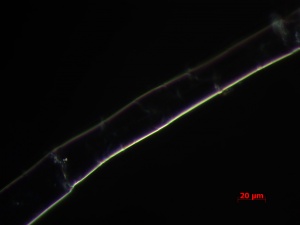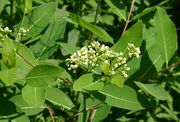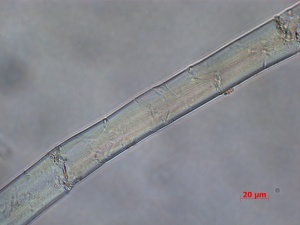Difference between revisions of "Dogbane"
| (5 intermediate revisions by the same user not shown) | |||
| Line 2: | Line 2: | ||
== Description == | == Description == | ||
| − | Dogbane (Apocynum cannabinum), also commonly known as "Indian hemp,' is a deciduous perennial herbaceous plant that grows throughout much of North America - in the southern half of Canada and throughout the United States. Bast fibers derived from the plant's inner bark have been used for fibers and cordage throughout North America. Dogbane is part of the Apocynaceae or dogbane family, which is shared with milkweeds, and is not related to true hemp despite one of its common names. | + | Dogbane (''Apocynum cannabinum''), also commonly known as "Indian hemp,' is a deciduous perennial herbaceous plant that grows throughout much of North America - in the southern half of Canada and throughout the United States. Bast fibers derived from the plant's inner bark have been used for fibers and cordage throughout North America. Dogbane is part of the Apocynaceae or dogbane family, which is shared with milkweeds, and is not related to true hemp despite one of its common names. |
All parts of the plant are poisonous and can cause cardiac arrest if ingested. Indian hemp fibers range from 1-2 meters long and are yellow to brown to gray in color. They have a high cellulose content with little lignin. Dogbane is lustrous, strong, and durable with good resistance to water, salts, light, and insects. Hemp is used for cordage, fishing lines, sailcloth, canvas, and burlap. Dogbane is also used for nets, snares and basketry. | All parts of the plant are poisonous and can cause cardiac arrest if ingested. Indian hemp fibers range from 1-2 meters long and are yellow to brown to gray in color. They have a high cellulose content with little lignin. Dogbane is lustrous, strong, and durable with good resistance to water, salts, light, and insects. Hemp is used for cordage, fishing lines, sailcloth, canvas, and burlap. Dogbane is also used for nets, snares and basketry. | ||
* For identification of dogbane fibers , see http://cameo.mfa.org/wiki/Category:FRIL:_Plant_Fibers | * For identification of dogbane fibers , see http://cameo.mfa.org/wiki/Category:FRIL:_Plant_Fibers | ||
| + | Including: | ||
| + | * Blue dogbane (''Amsonia tabernaemontana'') | ||
| + | * Intermediate dognbane (''Apocynum floribundum'') | ||
| + | * Spreading dogbane (''Apocynum androsaemifolium'') | ||
== Synonyms and Related Terms == | == Synonyms and Related Terms == | ||
| − | + | ''Apocynum cannbinum L''; Indian hemp; amy root; hemp dogbane; prairie dogbane; rheumatism root; or wild cotton; cáñamo indio (Esp.) ; hennep (Ned); | |
== Other Properties == | == Other Properties == | ||
| Line 130: | Line 134: | ||
== Additional Information == | == Additional Information == | ||
| − | T.Collings, D. Miller, 'The Identification of Oriental Paper Fibers' ''The Paper Conservator'', vol 3, 1978. | + | * T.Collings, D. Miller, 'The Identification of Oriental Paper Fibers' ''The Paper Conservator'', vol 3, 1978. |
| − | [[Category:Materials database]] [[ | + | [[Category:Materials database]] [[Category: FRIL]] |
Latest revision as of 13:30, 22 July 2022
Description
Dogbane (Apocynum cannabinum), also commonly known as "Indian hemp,' is a deciduous perennial herbaceous plant that grows throughout much of North America - in the southern half of Canada and throughout the United States. Bast fibers derived from the plant's inner bark have been used for fibers and cordage throughout North America. Dogbane is part of the Apocynaceae or dogbane family, which is shared with milkweeds, and is not related to true hemp despite one of its common names.
All parts of the plant are poisonous and can cause cardiac arrest if ingested. Indian hemp fibers range from 1-2 meters long and are yellow to brown to gray in color. They have a high cellulose content with little lignin. Dogbane is lustrous, strong, and durable with good resistance to water, salts, light, and insects. Hemp is used for cordage, fishing lines, sailcloth, canvas, and burlap. Dogbane is also used for nets, snares and basketry.
- For identification of dogbane fibers , see http://cameo.mfa.org/wiki/Category:FRIL:_Plant_Fibers
Including:
- Blue dogbane (Amsonia tabernaemontana)
- Intermediate dognbane (Apocynum floribundum)
- Spreading dogbane (Apocynum androsaemifolium)
Synonyms and Related Terms
Apocynum cannbinum L; Indian hemp; amy root; hemp dogbane; prairie dogbane; rheumatism root; or wild cotton; cáñamo indio (Esp.) ; hennep (Ned);
Other Properties
Resistant to water and alkalis. Damage by weak acids and bleaches.
Fiber length = 1-2 m. Fibers have a smooth cell wall with horizontal striations that are often packed close together.
Hazards and Safety
Combustible, may ignite spontaneously when wet.
Fiber Identification

IH-020-06-24-09-DF-400X-PM-3-9 |
|
Additional Information
- T.Collings, D. Miller, 'The Identification of Oriental Paper Fibers' The Paper Conservator, vol 3, 1978.

